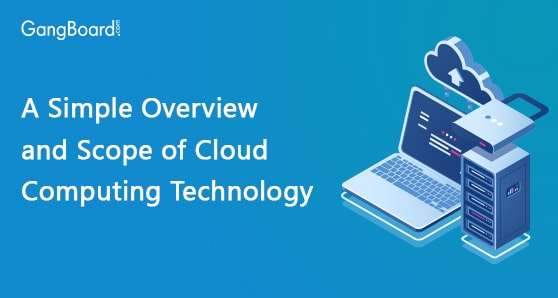
A Simple Overview and Scope of Cloud Computing Technology
At the mere mention of the term “cloud computing”, people’s minds begin to race. “What do you mean by cloud computing?” is a quintessential example of the questions that resonate in their minds. To put their minds to rest, this article gives a basic yet concise overview of what cloud computing technology is all about. Simply put, cloud computing refers to storage and access of data and programs over the internet (which in this context is referred to as the cloud). As Microsoft put it, “Cloud Computing is the delivery of computing services – servers, storage, databases, networking, software, analytics, and more – over the internet”.
Conventional access to files and programs stored on our computers require a physical hard drive/storage device, but the exact opposite is what cloud computing offers. With cloud computing, analyzing data, hosting websites and blogs, creating new services and apps and even storing data becomes a less daunting task.
Why would anyone want to use Cloud Computing Online Training? How important is it? What are the advantages and disadvantages of embracing cloud computing technology?
Here’s a Rundown of Some of the Benefits of Cloud Computing
- Cost Effective: Cloud computing is cost effective, literally. Companies are saved the stress and costs of purchasing hardware and software, maintaining servers and data centers as well as electricity costs, which in turn lessens the expenses they incur in the course of running their business, whilst helping them channel their attention and funds to other areas that need it. Cloud computing isn’t cheap, but it is less expensive.
- Reliability: With cloud computing, companies wouldn’t worry about being offline since most cloud service providers offer SLA (Service Level Agreement) that gives 99.99% round the clock uptime for their cloud computing platforms.
- Ease of Access: Using cloud computing technology, collaborations can be done with ease from anywhere in the world with a good internet connection. You simply have access to all your data at your fingertips without necessarily carrying any storage devices.
- Secure: Cloud service providers ensure that they offer the best security services that keep your data safe and secure – backups may be available at your request. You’re saved the stress of losing the data on your hardware in cases of theft.
In the Same Vein, the Disadvantages Though Negligible, Include
- Maintenance Downtimes and Security issues: To keep up to date with the latest software, security updates, and hardware, cloud service providers may sometimes take their services down, although they do issue prior notices.
- Inflexibility and Data Transfer Costs: Look before you leap into the arms of any cloud computing service provider because moving your data from one to the other may not be such a pleasant task. More so, transferring large amounts of data can become pretty expensive. There’s also the issue of limited control with some providers.
There are various types of cloud services otherwise called cloud computing stacks, divided into 3 broad categories;
- Infrastructure-as-a-Service (IaaS) – This has to do with renting IT infrastructure from cloud computing providers in India like CTRLS.
- Platform-as-a-Service (PaaS) – This deals with the provision of an environment for developers to develop, test, deliver and manage their applications.
- Software-as-a-Service (SaaS) – This deals with delivering software applications over the internet.
Some companies provide other services like
- Backup-as-a-Service (BaaS)– Provision of cloud backup services
- Disaster Recovery-as-a-Service (DRaaS) – Provision of a separate cloud platform for clients to easily switch over in the case of failure of the main platform.
Companies can deploy cloud services in 3 different forms; a public cloud which entails ownership of the cloud services by 3rd party cloud service providers, the private cloud which is owned by the company without the need for third-party providers, and the hybrid cloud, a combination of the public and private clouds.
Closing Thoughts
Cloud computing may not be generally accepted now, but a few more years and anyone who’s not using a cloud service would be regarded as being in the Stone Age. Its futuristic nature ensures that some of the services we have today will be improved further as it evolves. Scope of Cloud Computing Training expands consistently making it more user friendly with each passing day. So, get started today, learn and adopt the latest cloud technology and reap the benefits of enhanced growth.


 +1 201-949-7520
+1 201-949-7520 +91-9707 240 250
+91-9707 240 250